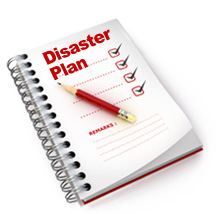 You have an Emergency Evacuation Plan. If disaster strikes, you have a plan to get everyone out of your facility calmly and safely… but then what? In case of fire or flood, or worse, do you have an emergency response plan to save and restore your property quickly and with minimal down time?
You have an Emergency Evacuation Plan. If disaster strikes, you have a plan to get everyone out of your facility calmly and safely… but then what? In case of fire or flood, or worse, do you have an emergency response plan to save and restore your property quickly and with minimal down time?
In a reactive industry, you need a proactive approach to disaster relief planning. Plan ahead. Think ahead. Train ahead. A Disaster Relief Plan can reduce your financial burden and reduce the time it takes to get your business back in business.
Some of the items that need to be included in your Disaster Relief Plan:
Entry and Access. Does your facility have any special security or badge procedures that would impede access for a restoration crew? If there are multiple access points, have routes been designated to expedite parking and entry to the appropriate areas? Just as you map out an emergency evacuation plan, you need to map out an emergency entrance plan.
Emergency Contact Tree. It’s 2 AM, do you know where you facility manager is? An emergency contact tree provides concise procedures and contact information so that you can communicate quickly and efficiently with all impacted personnel – building managers, owners, security, engineers, janitorial, parking garage managers, tenants and emergency coordinators. Having identified a certified restoration partner as part of your emergency response team can play a key role in protecting your building and its occupants.
Floor Plan. Do any offices in your building have sensitive areas? Identifying any special tenant needs and/or procedures will ensure that in case of emergency time-sensitive materials and/or equipment can be addressed as quickly as possible. Mapped floor plans will also enable emergency and restoration crews to have pre-existing documentation for quick identification of water shut off valves, breaker boxes, janitorial closets, pre-existing damage and other information unique to your facility that will help crews know where to go as quickly as possible. As part of a building assessment, the Disaster Relief Plan will also identify potential building risks, evaluate and rank priority response areas as well as determine training and monitoring needs.
In case of an emergency, response time will be critical to saving your property from total destruction. Having a well-thought out, up-to-date Disaster Relief Plan can help emergency and restoration crews be as proactive as possible in saving your property and the contents housed within. Time is also money. With construction crews on the scene, you want to maximize billable hours. Making sure crews know where to go, what type of building needs they are walking into and who to coordinate with will help restoration teams act quickly to save your property and reduce your billable hours.
Don’t have a Disaster Relief Plan? RestorationHQ offers priority agreements to help you develop a proactive emergency response plan and reduce your financial burden. Learn more at www.restorationhq.us.

